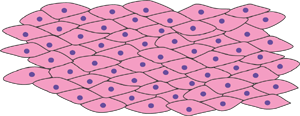Basic common structure

The basic plan of all the blood vessels (except the
capillaries) that make up the cardiovascular system consists of
these three layers.
- Tunica intima
- Tunica media
- Tunica adventitia
The walls of the cardiovascular system have a
single layer of muscle while those of the gastrointestinal
tract for example have two, or in some
regions three, layers of muscle.
 How could you explain this difference?
How could you explain this difference?
Tunica adventitia

This is the outermost coat. It consists of a
simple squamous
epithelium, basement
membrane, connective
tissue, blood vessels, and sometimes smooth
muscle cells.
This layer needs its own blood supply because it is quite thick.
The blood vessels that supply the tunica adventitia are called
vasa vasorum (vessels of the vessels).
Tunica media

This consists of concentric layers of smooth muscle fibres
and elastin. Some small blood vessels lack muscle fibres and elastin.
Tunica intima

This is the innermost coat. In blood vessels the simple squamous
lining cells (epithelium) is called the endothelium.
The tunica intima consists of the endothelium
and underlying basement membrane. A small amount
of subendothelial connective tissue and and internal elastic layer
(lamina), is sometimes present in some blood vessels.

 How could you explain this difference?
How could you explain this difference?
